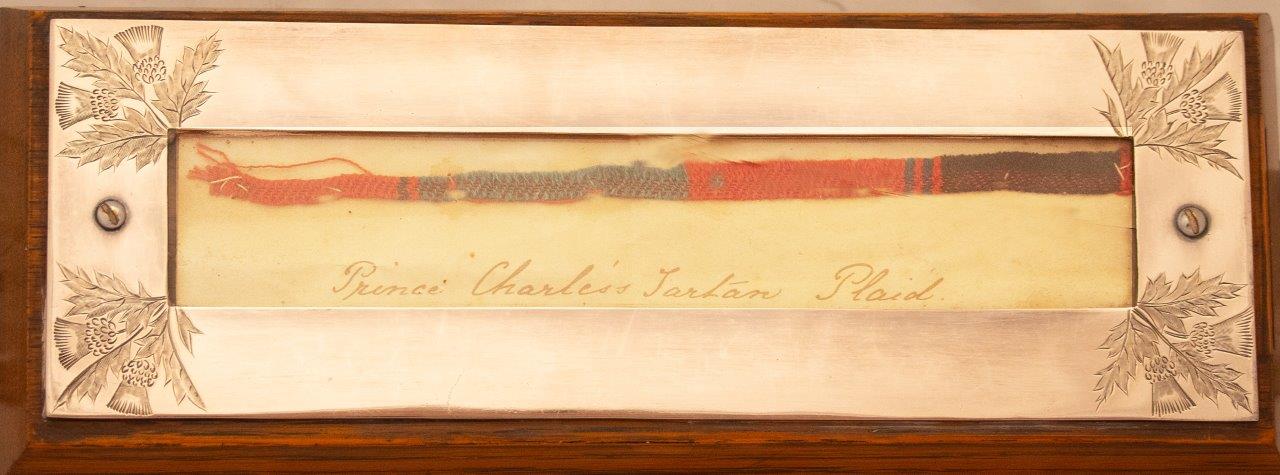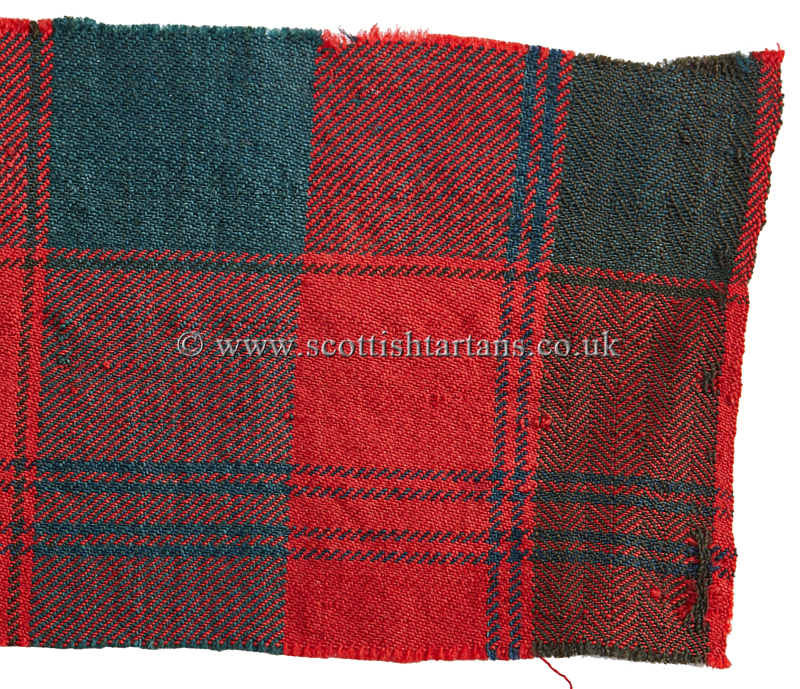The 31st December 2020 marks the 300th anniversary of the birth of Prince Charles Edward Stuart. To commemorate this special occasion the West Highland Museum has organised a series of articles written by scholars, academics, authors, and Jacobite enthusiasts. In this tenth in the series, tartan historian Peter Eslea MacDonald focuses on a fragment of plaid in the museum’s collection.
A Fragment of Prince Charlie’s Tartan Plaid
Amongst the various pieces of old tartan in the collection of the West Highland Museum is a framed specimen labelled ‘Cut from Prince Charles Edward’s plaid’ (WHM Acc No 2191). It was gifted to the Museum in 1973 as part of the Bequest from Dr Charles A Hepburn, a collector of Jacobite memorabilia. The fragment is small, approx. seven inches by a quarter of an inch, but even so, there is enough to allow it to be compared with a number of similar specimens with the same attribution held in collections elsewhere. Of note, this piece includes a section of herringbone weave at the edge (the selvedge). This feature, together with other elements of the pattern, confirms this is the same tartan that of the Moy Hall Plaid[1] given to Lady MacKintosh[2] by Prince Charles Edward Stuart when he stayed in February 1746, the occasion of the famous Rout of Moy.

Prince Charles Edward (PCE) is said to have given tartan pieces as gifts to supporters he stayed with, some may even have been gifts to him that he recycled. The story of the Prince’s association led to the Moy Hall Plaid being revered as a Jacobite relic and it was subsequently divided amongst Charles supporters as a keepsake. It’s not known when the original plaid was divided but in the writer’s opinion it was almost certainly done by Lady Anne MacKintosh; she died in 1787[3]. It seems likely that it would have been ‘..divided among the then members of the chief’s family..’ shortly after the ’45 when the memory of the Prince was at its strongest; c1750-60 is a reasonable hypothesis.
At the height of the Highland Revival in the early 1800s attempts were made to reproduce the design based on a large piece of the original plaid retained at Moy. Unfortunately, that undertaking was flawed and modern research revealed that the original pattern differed from the reconstruction. Further copies were made in the period 1830-40, none of which were exactly the same, however they in turn have been divided up, confused with the original and the story of the plaid in turn attached to them. As a result, upwards of twenty specimens survive in museums and private collections, all of which are claimed to be part of the original plaid. How then can we be sure that any individual specimen is a piece of the original plaid and not from one of the subsequent copies? It is fortunate that a piece of the original plaid is still owned by the MacKintoshes at Moy Hall. The specimen is 231/2 inches wide but incomplete, stopping just short of the second selvedge. However, the intact side includes a seven-bar herringbone selvedge mark of 10 threads each that starts on the second thread, technically a threading error. This structure and error are found in some other pieces which confirm these to have been part of the original plaid. Only one selvedge of the original material would have been herringboned, the other being plain and intended for joining two sections of material. To date, no surviving specimen of the second selvedge has been found.
Section of the Moy Hall Plaid showing detail of the herringbone selvedge.

Unlike the Moy Hall piece, the herringbone section of the West Highland Museum specimen begins on the thirteenth thread of the selvedge mark and contains six uneven bars. It is identical to pieces in the Royal Museum of Scotland and Inverness Museum, plus one in a private collection. The difference in the selvedge mark structure means that these pieces cannot have been cut from the same plaid as that still at Moy Hall.
A number of the surviving pieces are associated with particular families which has led to the tartan being claimed by a particular clan and to them having been the original owners of the Moy Hall plaid. There is absolutely no evidence to support any of these claims. Unfortunately, there is no information about when or from where Dr Hepburn acquired his fragment but based on the structure of the material it is likely that the cloth was one of the later copies. Ongoing study will hopefully identify other specimens that will help tell the story of this evocative piece.
Peter Eslea MacDonald
[1] Moy Hall, often spelt Moyhall, is the seat of the MacKintosh chief.
[2] Lady Anne MacKintosh, also known as Colonel Anne, was a Jacobite heroine and wife of the chief, a Hanoverian Officer.
[3] Lady Anne was pre-deceased by her husband, Angus, the 22nd chief, and died without issue. Moy Hall and contents, including the plaid (or remnant if already divided as speculated by the author) passed to Angus’ nephew, Aneas, 23rd chief.
